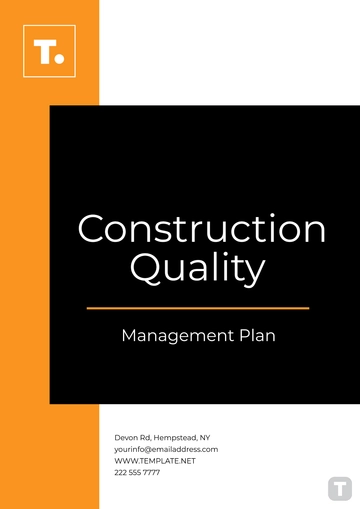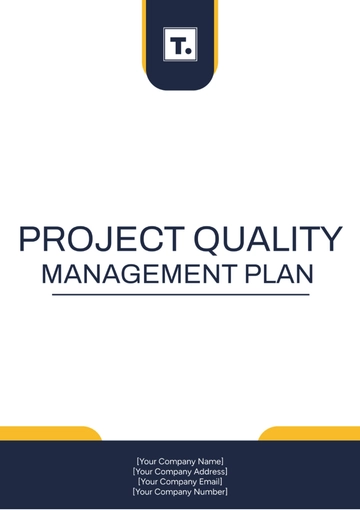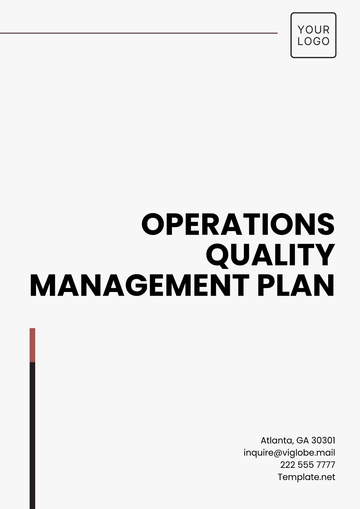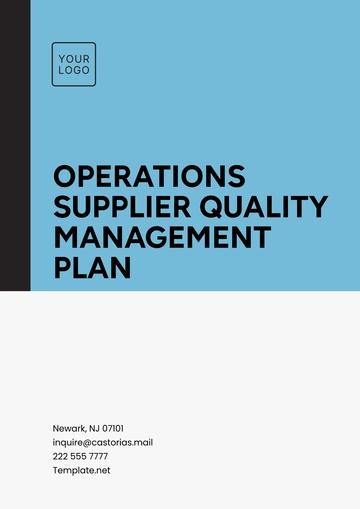Free Operations Supplier Quality Management Plan
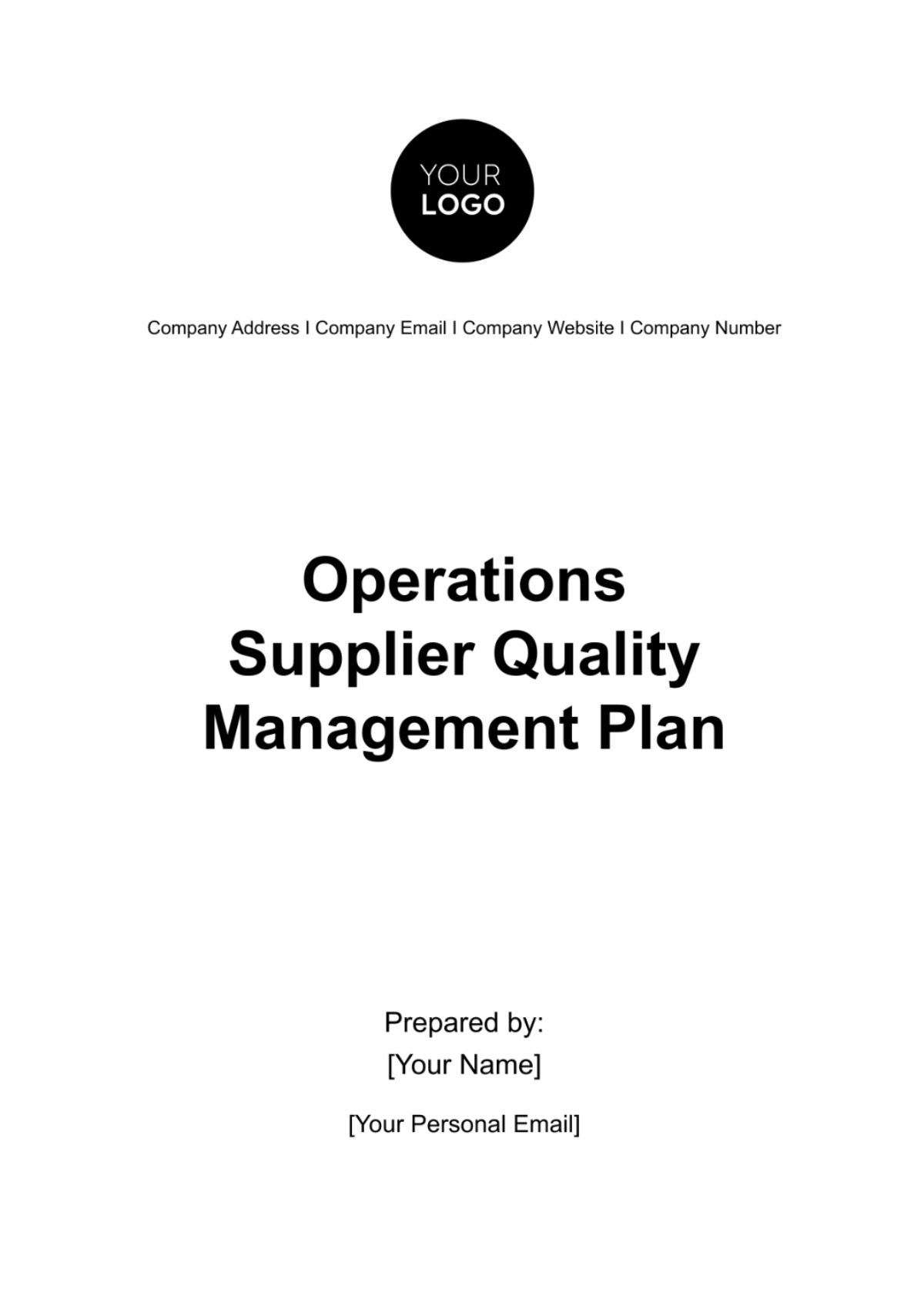
Prepared By: | [Your Name] |
Company: | [Your Company Name] |
Date: | [Date] |
1. Introduction
This Operations Supplier Quality Management Plan outlines the processes and expectations for ensuring the quality of goods and services provided by suppliers. It aims to align supplier performance with organizational standards and operational goals, ensuring consistent delivery of high-quality products and services.
2. Purpose and Scope
The plan aims to:
Define supplier quality expectations and compliance requirements.
Establish procedures for supplier evaluation, monitoring, and improvement.
Reduce risks related to supplier quality issues.
This plan applies to all suppliers involved in the procurement of materials, components, and services that impact organizational operations.
3. Roles and Responsibilities
Quality Management Team:
Set quality standards and conduct supplier audits.
Review supplier performance and initiate corrective actions.
Procurement Team:
Select and manage suppliers in compliance with this plan.
Maintain supplier records and performance data.
Suppliers:
Ensure products and services meet quality requirements.
Address and resolve quality concerns promptly.
4. Supplier Quality Requirements
Suppliers are required to:
Meet or exceed defined quality standards.
Adhere to applicable regulations and certifications.
Implement a robust quality management system.
5. Supplier Qualification Process
1. Pre-Qualification:
Evaluate supplier capabilities, including production capacity, quality systems, and regulatory compliance.
2. Approval:
Suppliers that meet all requirements are added to the Approved Supplier List.
3. Periodic Requalification:
Ongoing assessments ensure suppliers maintain required standards.
6. Performance Monitoring and Evaluation
Suppliers are evaluated using key performance indicators (KPIs), such as:
On-time delivery rates.
Product defect rates.
Compliance with agreed specifications.
Regular performance reviews are conducted, and feedback is shared with suppliers to drive improvements.
7. Quality Control and Auditing
Incoming Inspections: Materials are inspected upon receipt to confirm compliance with specifications.
Audits: Periodic audits assess supplier processes, adherence to standards, and overall performance.
Product Testing: Random testing is performed to ensure consistent quality.
8. Corrective and Preventive Actions (CAPA)
Corrective Actions
Suppliers must identify the root causes of quality issues, implement corrective measures, and submit detailed reports.
Preventive Actions
Suppliers are encouraged to develop strategies to prevent recurring problems.
9. Continuous Improvement
The organization and suppliers collaborate to:
Enhance product and service quality.
Optimize production processes and reduce costs.
Adapt to changes in market and industry standards.
10. Conclusion
The Operations Supplier Quality Management Plan ensures a structured approach to managing supplier relationships and maintaining quality standards. Through collaboration, monitoring, and continuous improvement, this plan fosters a partnership that benefits both the organization and its suppliers.
- 100% Customizable, free editor
- Access 1 Million+ Templates, photo’s & graphics
- Download or share as a template
- Click and replace photos, graphics, text, backgrounds
- Resize, crop, AI write & more
- Access advanced editor
Optimize supplier quality with our editable Operations Supplier Quality Management Plan Template—a comprehensive framework for startups to implement robust quality management practices. Customizable via Template.net's AI Editor Tool, this plan enables you to define supplier performance metrics, conduct regular audits, and collaborate with suppliers to drive continuous improvement. Elevate your operations today!
You may also like
- Finance Plan
- Construction Plan
- Sales Plan
- Development Plan
- Career Plan
- Budget Plan
- HR Plan
- Education Plan
- Transition Plan
- Work Plan
- Training Plan
- Communication Plan
- Operation Plan
- Health And Safety Plan
- Strategy Plan
- Professional Development Plan
- Advertising Plan
- Risk Management Plan
- Restaurant Plan
- School Plan
- Nursing Home Patient Care Plan
- Nursing Care Plan
- Plan Event
- Startup Plan
- Social Media Plan
- Staffing Plan
- Annual Plan
- Content Plan
- Payment Plan
- Implementation Plan
- Hotel Plan
- Workout Plan
- Accounting Plan
- Campaign Plan
- Essay Plan
- 30 60 90 Day Plan
- Research Plan
- Recruitment Plan
- 90 Day Plan
- Quarterly Plan
- Emergency Plan
- 5 Year Plan
- Gym Plan
- Personal Plan
- IT and Software Plan
- Treatment Plan
- Real Estate Plan
- Law Firm Plan
- Healthcare Plan
- Improvement Plan
- Media Plan
- 5 Year Business Plan
- Learning Plan
- Marketing Campaign Plan
- Travel Agency Plan
- Cleaning Services Plan
- Interior Design Plan
- Performance Plan
- PR Plan
- Birth Plan
- Life Plan
- SEO Plan
- Disaster Recovery Plan
- Continuity Plan
- Launch Plan
- Legal Plan
- Behavior Plan
- Performance Improvement Plan
- Salon Plan
- Security Plan
- Security Management Plan
- Employee Development Plan
- Quality Plan
- Service Improvement Plan
- Growth Plan
- Incident Response Plan
- Basketball Plan
- Emergency Action Plan
- Product Launch Plan
- Spa Plan
- Employee Training Plan
- Data Analysis Plan
- Employee Action Plan
- Territory Plan
- Audit Plan
- Classroom Plan
- Activity Plan
- Parenting Plan
- Care Plan
- Project Execution Plan
- Exercise Plan
- Internship Plan
- Software Development Plan
- Continuous Improvement Plan
- Leave Plan
- 90 Day Sales Plan
- Advertising Agency Plan
- Employee Transition Plan
- Smart Action Plan
- Workplace Safety Plan
- Behavior Change Plan
- Contingency Plan
- Continuity of Operations Plan
- Health Plan
- Quality Control Plan
- Self Plan
- Sports Development Plan
- Change Management Plan
- Ecommerce Plan
- Personal Financial Plan
- Process Improvement Plan
- 30-60-90 Day Sales Plan
- Crisis Management Plan
- Engagement Plan
- Execution Plan
- Pandemic Plan
- Quality Assurance Plan
- Service Continuity Plan
- Agile Project Plan
- Fundraising Plan
- Job Transition Plan
- Asset Maintenance Plan
- Maintenance Plan
- Software Test Plan
- Staff Training and Development Plan
- 3 Year Plan
- Brand Activation Plan
- Release Plan
- Resource Plan
- Risk Mitigation Plan
- Teacher Plan
- 30 60 90 Day Plan for New Manager
- Food Safety Plan
- Food Truck Plan
- Hiring Plan
- Quality Management Plan
- Wellness Plan
- Behavior Intervention Plan
- Bonus Plan
- Investment Plan
- Maternity Leave Plan
- Pandemic Response Plan
- Succession Planning
- Coaching Plan
- Configuration Management Plan
- Remote Work Plan
- Self Care Plan
- Teaching Plan
- 100-Day Plan
- HACCP Plan
- Student Plan
- Sustainability Plan
- 30 60 90 Day Plan for Interview
- Access Plan
- Site Specific Safety Plan
